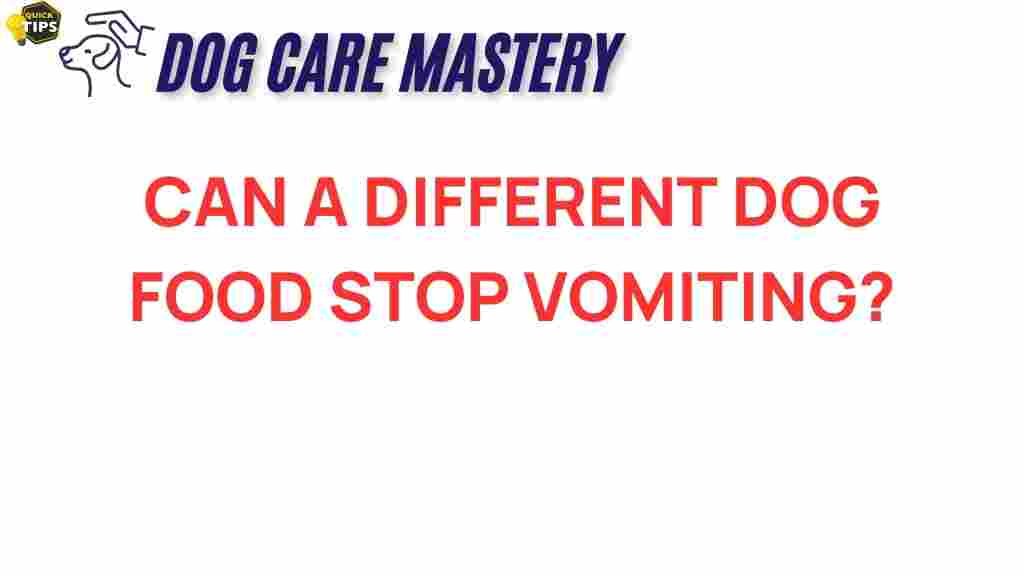Can Changing Your Dog’s Food Help Stop Vomiting?
As a dog owner, seeing your furry friend vomit can be distressing. Vomiting in dogs can occur for various reasons, and often, the food they consume plays a significant role. In this article, we will explore how changing your dog’s food might help stop vomiting, the types of dog food available, and steps you can take to ensure your pup’s digestive health. By understanding the connection between dog food and vomiting, you can make informed decisions for your pet’s well-being.
Why Do Dogs Vomit?
Before we dive into how changing dog food can help, it’s essential to understand the reasons behind vomiting. Dogs may vomit due to:
- Eating too quickly
- Food intolerances or allergies
- Ingesting foreign objects
- Dietary changes
- Illness or infection
- Medication side effects
If your dog is vomiting frequently, it’s crucial to consult your veterinarian to rule out serious health issues. However, if the vomiting is sporadic and seems related to diet, changing your dog’s food may be a viable solution.
The Role of Dog Food in Digestive Health
The type of dog food you choose can significantly affect your dog’s digestive health. High-quality dog food is formulated to meet a dog’s nutritional needs and is easier on their stomach. Here are some aspects of dog food that can influence vomiting:
Ingredients
Some dogs may have sensitivities to certain ingredients commonly found in dog food, such as:
- Grains (like wheat or corn)
- Meat by-products
- Artificial additives
Choosing a dog food that lists high-quality, recognizable ingredients can help mitigate this issue.
Fat Content
Dog foods that are high in fat can lead to digestive upset and vomiting. Opt for a dog food with a moderate fat content, especially if your dog has a history of gastrointestinal issues.
Fiber Content
Adequate fiber in dog food may help prevent constipation and promote healthy digestion. Foods that are too low in fiber can lead to digestive problems, including vomiting.
When to Change Your Dog’s Food
Changing your dog’s food may be necessary if:
- Your dog has been vomiting after meals consistently.
- There are changes in your dog’s appetite or energy levels.
- Your vet has recommended a dietary change.
Before making any changes, it’s advisable to consult with your veterinarian to ensure the new food will be appropriate for your dog’s specific needs.
Step-by-Step Process to Change Your Dog’s Food
When transitioning your dog to a new food, it’s important to do so gradually to avoid further gastrointestinal upset. Here is a step-by-step process:
Step 1: Choose the Right Dog Food
Look for a high-quality dog food that is suitable for your dog’s age, size, and specific health needs. You might consider:
- Grain-free options if your dog has grain sensitivities
- Limited ingredient diets for allergies
- Veterinary-prescribed diets for specific health conditions
Step 2: Gradual Transition
To avoid upsetting your dog’s stomach, gradually introduce the new food over a week. Follow this general guideline:
- Days 1-2: 25% new food, 75% old food
- Days 3-4: 50% new food, 50% old food
- Days 5-6: 75% new food, 25% old food
- Day 7: 100% new food
Step 3: Monitor Your Dog
During the transition, observe your dog for any signs of vomiting or digestive upset. If vomiting occurs, slow down the transition process and consult your vet.
Troubleshooting Tips
If changing your dog’s food doesn’t seem to stop the vomiting, consider the following troubleshooting tips:
Hydration
Ensure your dog is well-hydrated, especially if they are vomiting. Offer them fresh water and consider adding an electrolyte solution designed for pets.
Feeding Schedule
Adjust your dog’s feeding schedule. If they tend to eat too quickly, try feeding smaller meals throughout the day instead of one or two large meals.
Minimize Stress
Stress can also contribute to vomiting in dogs. Create a calm and quiet eating environment, and avoid sudden changes to their routine.
Consulting Your Vet Again
If vomiting persists after changing your dog’s food and following the above tips, it’s crucial to consult your veterinarian. They may recommend further diagnostic tests to identify any underlying health issues.
Conclusion
In summary, changing your dog’s food can potentially help stop vomiting, especially if it’s related to dietary intolerances or low-quality ingredients. By understanding the role of dog food in your dog’s health and following a careful transition process, you can enhance your pet’s well-being. Always monitor your dog during this change and consult your veterinarian if issues persist. For more tips on dog health and nutrition, check out our other articles here. For a deeper understanding of dog nutritional needs, refer to the guidelines from the American Kennel Club here.
This article is in the category Health and created by dogcaremastery Team
